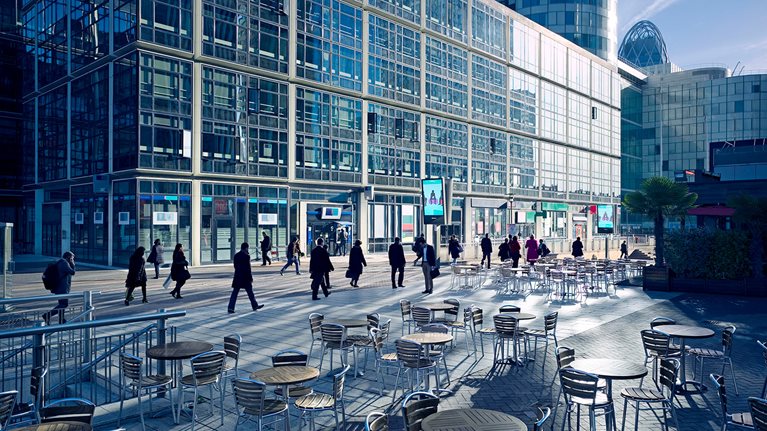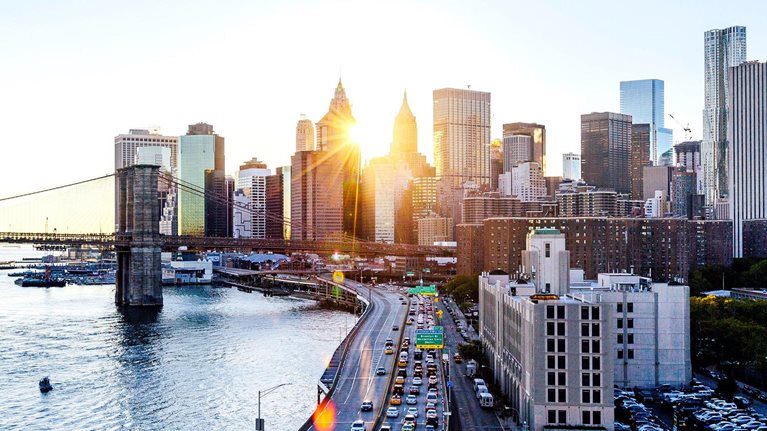The pandemic has dramatically changed the way people work, live, and shop in superstar cities. As we described earlier in this report, the rise of hybrid work has encouraged people to work at the office less, move to homes that are farther from the office, and shop less in urban cores. The result is higher vacancy rates, which threaten the vibrancy of neighborhoods and make urban cores less attractive to employers, employees, and residents (see sidebar, “How we define cities,” in the executive summary).
These are challenges, to be sure, but they also present an opportunity for historic transformation in superstar cities. To adapt to a new reality in which hybrid work is widespread and permanent, urban stakeholders could consider adopting more hybrid approaches themselves. At the neighborhood and building levels, and even in the design of the floors of buildings, choosing diversity, adaptability, and flexibility rather than uniformity can help cities thrive.
At the neighborhood level, consider mixed-use development
One way cities could adapt is through mixed-use neighborhoods—that is, neighborhoods that are not dominated by a single type of real estate (especially offices) but instead accommodate a diverse mix of office, residential, and retail space. Such hybrid neighborhoods were becoming more popular even before the pandemic. And now that the pandemic has reduced demand for offices, cities have been left with vacant space that could be converted to other uses. Furthermore, our research shows that mixed-use neighborhoods have suffered less during the pandemic than have office-dense neighborhoods. That resilience gives investors, developers, and cities still more reason to engage in placemaking.
Redeveloping neighborhoods is an enormous undertaking, of course, so mobilizing the many stakeholders is important. Governments may be particularly helpful in reforming restrictive zoning policies. Investors would be needed to finance redevelopment (see sidebar, “Investing in the future of urban real estate”). And developers would be the ones to turn mixed-use visions into realities. Before they break ground on a mixed-use project, leading developers carefully consider the different types of journeys they want to enable for residents, employees, and shoppers—for example, how a resident might proceed from her apartment to a café to a subway station in the morning, or how an office employee might shop for groceries on his way home from work.
Lower Manhattan might serve as a model of how to encourage mixed uses. After the September 11 attacks there, many newly vacant office buildings were converted into residential buildings. The city and state governments encouraged those conversions by streamlining the zoning and permitting processes and by providing tax incentives. But not every attempt to diversify a neighborhood needs to be that ambitious, as is shown by another New York example—the High Line, an old railroad slated for demolition that was converted into a widely acclaimed urban park.
Suburbs can benefit from hybridity as well. City dwellers, untethered from their daily commutes and thus less concerned about living far from urban cores, are increasingly seeking larger homes in greener areas. More housing and retail in the suburbs could help satisfy their preferences. More multifamily housing could be particularly beneficial because it would accommodate more people than single-family homes do. So long as the apartments are larger and more comfortable than apartments in urban cores, they could attract urbanites seeking space. Suburban policy makers could consider encouraging multifamily development by adjusting zoning, offering incentives to developers, and reexamining regulations that prevent housing from being built, such as those governing minimum dwelling sizes. Furthermore, denser suburbs would bring social and environmental benefits (see sidebar, “Affordable, sustainable real estate after the pandemic”).

At the building level, construct space that is adaptable and flexible
To adapt to declining demand for traditional office and retail space, developers could create hybrid buildings. The most ambitious vision is a universal, “neutral-use” building whose design, infrastructure, and technology could be easily modified to serve different uses. Imagine a medical building that could be easily converted into, say, a hotel or an apartment building if customers’ preferences changed. More modestly, buildings could be designed to accommodate different degrees of collaborative and individual work or different arrangements of open and closed offices. They could also include technology that promotes flexibility, such as sensors to track patterns of usage, which can inform an employer’s approach to hybrid work.
Hybrid buildings would bring at least two advantages. One, of course, is that they would protect owners from shifts in preferences that are impossible to predict now. The second relates to a trend toward shorter leases in the office sector. Because tenants will now be moving in and out more frequently, buildings might become more valuable if they grow more adaptable.
Developers could also try to convert offices into kinds of space for which there is more demand, such as apartments, hotels, and schools. Conversions are very hard, however. Obstacles include rezoning, renegotiating existing lease commitments to allow for renovations (for example, if just a few tenants remain in a building but they have a lot of time left on their leases), and dealing with physical limitations (for example, the usual layout of office buildings, which is difficult to divide into apartment-sized dwellings that receive natural light). Conversions are also not a panacea: even a large number of them would not meaningfully improve affordability (see sidebar, “Affordable, sustainable real estate after the pandemic”). Still, for owners facing the prospect of lower occupancy and lower rents in their office buildings, the opportunity cost of conversion has fallen, and the number of successful conversions may grow.
Developers of retail space too could keep adaptability in mind. Of late, retail tenants have been evaluating their footprints with a stricter eye, shutting down stores or moving into smaller spaces. For example, the average size of a store fell from about 3,400 square feet in 2019 to about 3,000 square feet in 2021.1 That shift was probably caused partly by the closure of large stores and partly by the opening of new store types, such as the mix of “grab and go” stores, pharmacy-focused stores, and “general stores” that a leading drugstore chain has recently launched to cater to different customer segments. If developers built more adaptable spaces, they would be likelier to remain relevant to tenants’ shifting needs. Developers might also offer new store formats, such as spaces intended for delivery and fulfillment or for logistics rather than traditional retail. Or they might design buildings that are more integrated with their environments—for example, with dining spaces that extend onto sidewalks.
At the floor level, design space that is modular and multiuse
Tenants in urban cores—both the employers who rent office space and the merchants who rent retail space—may have to start “earning the commute” from office workers and shoppers who would otherwise visit less often. They can do that by providing more attractive experiences. Here too, thinking flexibly and adaptably can help.
For example, the office does not have to be just a place to work; it can also be a place where employees enjoy amenities provided by their employers, such as outdoor communal spaces and compelling events. Office tenants might try to attract them by building magnetic, hospitality-oriented workplaces. (Those that find it difficult to create such an environment in their own offices might rely on providers of coworking space or landlord-provided community workspaces.) Office tenants might also design more modular spaces that can adapt to changes in work patterns from week to week. And the most forward-thinking tenants will provide an efficient, digital way to organize hybrid work patterns and preferences.
Retailers too may have to “earn the commute” by designing spaces that cater to many different uses. A prime example is stores that easily accommodate omnichannel retail—a single, seamless experience for customers, whether they shop online or in person. The omnichannel experience is quickly becoming the industry standard. Similarly, stores can provide experiential retail. For example, a leading US sporting goods company is testing a new type of store that doubles as a community sports center, and a department store brand is launching smaller stores where customers can pick up products bought online, get clothes altered, find style advice, and patronize a beauty salon.
Indeed, it is not hard to imagine more “hybrid floors” in which offices, residences, and stores exist side by side. For floors—as for buildings and neighborhoods—turning empty spaces into hybrid places may not simply be a way to counter the damage wrought by the pandemic. It could be a way to transform superstar cities and prepare them for a dynamic, prosperous future.


